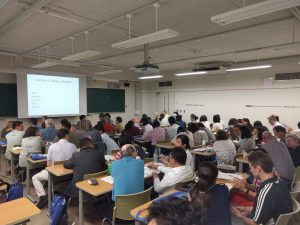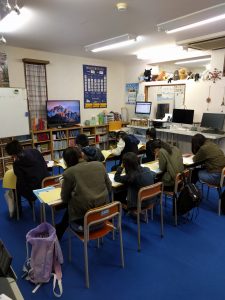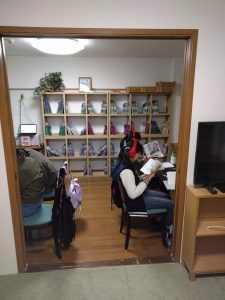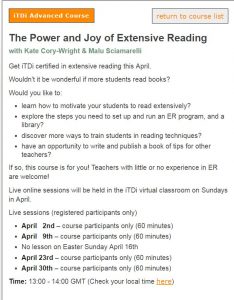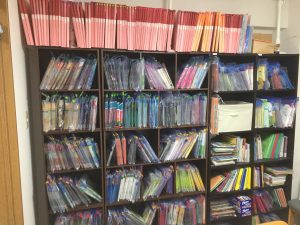ERWC4: The Last Lecture
Went pretty well
I attended the Extensive Reading World Congress last week and gave my last presentation on teaching. Over sixty people were kind enough to attend the 2.5 hour workshop, and we had a very productive session.
The workshop was run PDR style, and we were able to cover four of the five topics I had prepared.
You can see the slides here, and the worksheets here. I think the content would be useful for someone thinking about starting or developing an ER program to work through.
Please feel free to post any questions or comments below.
conference extensive reading presentations school management teaching
by sendaiben
6 comments
The Last Lecture (well, workshop)
ER Program Design and Implementation
Extensive Reading World Congress, Toyo Gakuen, Tokyo
Friday August 4th, 15:30-18:00
At the beginning of next month I’ll be doing a pre-conference workshop at the Extensive Reading World Congress in Tokyo. This will be my last presentation on education.
The title is the same as the book I have been thinking about writing for the last few years. The content too. In a way, it’s the summary of the last ten years of my work as a teacher. I hope it comes together the way I would like it to. If it does it should be a pretty comprehensive introduction to all aspects of designing and running an extensive reading program at the institutional level.
It’s a workshop, so we’ll be doing work. I’m going to use the PDR (preparation, discussion, reaction) framework to structure the group discussions and will cover the following areas:
- Designing a Program
- Selling a Program
- Setting up a Program
- Running a Program
- Leaving a Program
If you come to the conference I hope you will consider spending a couple of hours with us on Friday. I can almost guarantee you will find it useful.
If you have any questions before the event feel free to post them in the comments below.
Academy curriculum expectations extensive reading junior high school
by sendaiben
12 comments
Cambridge Academy: Another Quantum Leap
The Academy Fluency Course
JHS 1st-year class doing verb exercises
We’re into week three of the new academic year, and we’re starting to see the results of the changes I wrote about in the previous update.
You can read previous Academy posts here:
- Extensive Reading for Secondary Students (April 2015)
- Six Months In (September 2015)
- Year One (February 2016)
- Looking at Year Two (March 2016)
- Stocktake (March 2016)
- Shadoku explained (April 2016)
- Some improvements to the curriculum (April 2016)
- December 2016 update (December 2016)
- Cambridge Academy: Year Two and Three (March 2017)
- Cambridge Academy: Stocktake 2017 (March 2017)
Our new reading classroom (the second)
I have to admit I was a bit jittery before classes started on April 1st. I was nervous about the new materials for the output classes, I was nervous about teaching six nights/twelve hours a week, and I was nervous about the larger class sizes.
It’s looking like I needn’t have been 🙂
New Materials
We’ve been working on the Fluency course for about a year now. We have year one in draft form, and will be using it with the three classes (28 students) of JHS 1st years we have this year as an alpha trial.
If anything, the materials work even better than I had hoped. Students have responded extremely well, they are visibly improving already, and the classes are just fun to teach.
The course is based on the New Horizon content, but vastly expanded and designed to get the students speaking, reading, and writing fluently. The first year of the course is 15,000 words long (three times the amount in all three years of New Horizon) and students explicitly study 720 words in the 48 lessons.
Students do speaking and writing practice, speed reading, verb/pronoun exercises, and memorize and write dialogues. They are constantly working for 60 minutes. It’s a beautiful thing to see and teach.
We also use Quizlet (search for CA OUTPUT 1 to see our lessons) to preview and practice vocabulary and questions for the class, and students do Duolingo as optional language practice.
This year we will write the second year of the course, and next year we’ll have a beta of the first-year course at Cambridge and at another partner school, while we do the alpha of the second-year course at Cambridge.
Teaching Six Nights/Twelve Hours a Week
This also went way better than I had expected. I didn’t intend to teach six nights a week, but we had so many students wanting to join that we chose to add another day (Mondays), as well as increase class sizes (see below) to accommodate them.
The classes are fun, and even with the extra preparation needed for the first couple of classes, have so far not been too overwhelming. I have an assistant in each class but, to be honest, haven’t really needed them so far.
Larger Class Sizes
This might be the best thing of all. Up until this year, all our classes had a maximum of six students in. This year due to unexpected demand (we were expecting up to twenty JHS1 students: we actually got twenty-eight) we increased the class size to ten.
I was expecting it to be more difficult to teach. I was also expecting the parents to be unhappy.
The thing is, with our new fluency course, it’s easier to run the class as students need less individual attention. The atmosphere actually improved with more students in the room. In fact, I think this will work equally well (or better!) with twenty or thirty students.
Parents haven’t complained. In fact, many of them have told us their children are really enjoying the classes.
So if we can secure a larger space I will try to increase class sizes to twenty next year 🙂
iTDI: The Power and Joy of Extensive Reading
I’m taking an online course about ER through iTDI. We had the first session this evening. So far it’s a pretty good introduction to the topic.
You can see a recording of the first session here. If you like it, please consider joining the rest of the course.
Maybe see you on there!
Academy curriculum extensive listening extensive reading high school junior high school school management
by sendaiben
2 comments
Cambridge Academy: Year Two and Three
Takeoff
The Academy appears to be taking off. We have over 30 JHS1 students starting next month, including half a dozen new prospects that found us through word of mouth (some of our students are doing very well in school) or from our new website. Our new fluency-based curriculum is ready for testing. We’ve rented a second reading classroom and are buying a lot of new books.
We haven’t reached 100 students yet (how naive that goal seems now) but we’re getting closer. We should definitely hit it next year if not before.
You can read previous Academy posts here:
- Extensive Reading for Secondary Students (April 2015)
- Six Months In (September 2015)
- Year One (February 2016)
- Looking at Year Two (March 2016)
- Stocktake (March 2016)
- Shadoku explained (April 2016)
- Some improvements to the curriculum (April 2016)
- December 2016 update (December 2016)
More importantly, we have learned a lot over the last few months and should be able to improve class content and avoid operational issues next year.
2016-17 Academic Year
Some highlights from this year:
- shadoku has been a huge success
- our students are starting to make real progress
- we had incredible eiken results this time round
- word of mouth from our success stories seems to be very positive
- students love graduating from guided ER to independent ER
- varied reading materials work very well (particularly comics)
Some lessons learned:
- we had a ‘pre-Academy’ course this year for elementary 6th grade students that just did reading but I am not at all happy with the results so we’ll be discontinuing it
- scheduling was a huge pain this year and some parents got annoyed with us
- our textbook choices were not great -need to tighten up the output class content
2017-18 Academic Year
A few big changes next year. The biggest is that I’ll be teaching all the junior high school classes, both input (reading) and output (communication). I’m doing this because I want to really work on the curriculum and trial our new fluency materials. We will have over fifty JHS students from April.
We’re increasing class sizes. Until now we’ve had output classes of six, but from April we’ll have up to ten students in a class. I think this should be okay, but I’ll have an assistant for each class just in case. For input classes with the new classroom we’ll be able to increase our max class size from 12 to 22.
We’ll be trialing our new fluency materials with thirty JHS1 students. Limited trials so far seem to indicate that the materials are interesting and easy-to-understand for students. We’ll see how they do over an entire academic year.
We’ll finally have some student manuals that explain the program and what students should be doing in Japanese. Based on my experience of using manuals with university students I expect this will make things more efficient. It will also help parents to understand what we are doing and why.
We’ll be making some administrative changes too to reduce friction and paperwork. The most important is that I already know what days of the week will be JHS1 classes from April 2018. This means we can tell parents about them sooner and have them sign up in January for classes (first come first served). We’ll be asking them to pay the annual fee in order to register, which should reduce sudden cancellations (or at least compensate us somewhat for them).
We’ll be buying a lot of books. I just ordered 300,000 yen’s worth of books for our YL0.1-0.2 library (to deal with those 30+ JHS1 students coming in next month). This will last us a few months, but then we’ll have to make a similar order for YL0.3-0.4, and so on. It looks like 30 is going to be our capacity for a while, so this should be a one-off this year.
I also expect to continue buying intermediate level (YL1.1+) books to expand our collection.
We rented a second reading classroom this month, and will be using it for the JHS1 classes. We’ll keep our current classroom but move the lower-level materials to the new classroom and keep the old one for older students.
Overall
So things are looking good. Growth is slower than I was expecting, but seems to be taking off. Next year should be a big improvement in class quality and I’m hoping to document what I do to make it easier to have other teachers run the classes. We intend to trial our JHS2 fluency materials in 2018 and JHS3 in 2019.
Finally, I think I have figured out how to share the Academy program with other schools. We are creating something called the Academy Mentor Program (AMP) which is basically a time-limited franchise (schools stop paying fees after a few years and can continue using the program). I think it’s a win-win-win. If all goes well we’ll be doing a Beta in 2018.
Anyone else doing interesting things with junior high school students? Would you be interested in getting support/materials/knowhow to launch your own Academy program? Any good books in the YL1.1-3.0 range?
